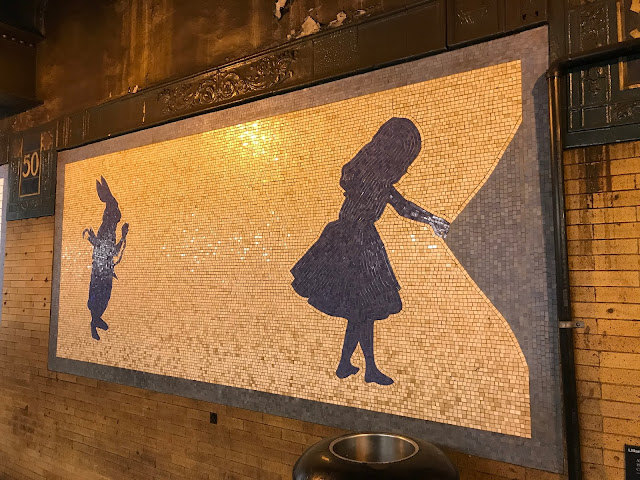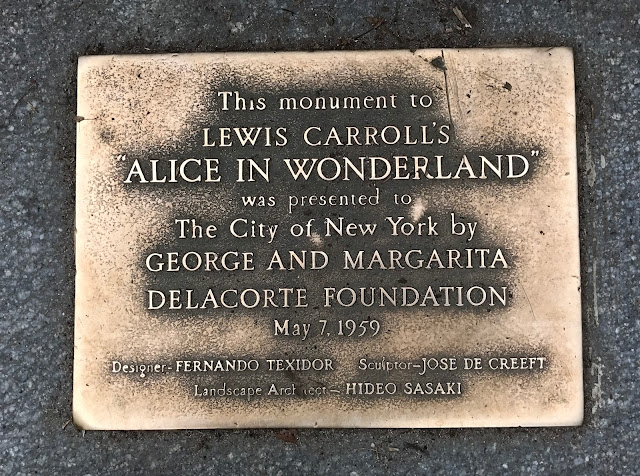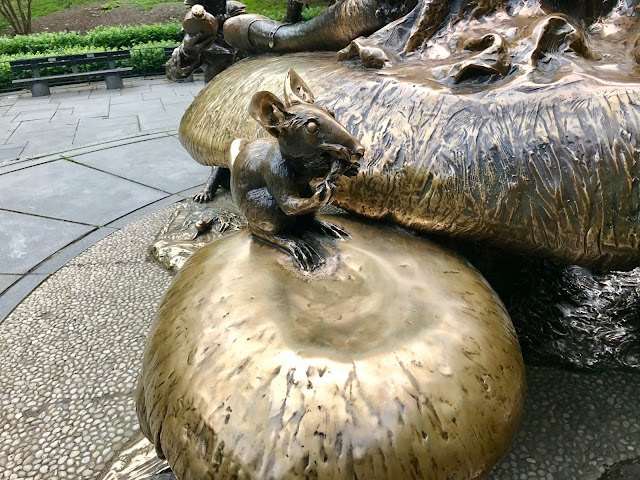Lewis Carroll's real name was Charles Lutwidge Dodgson and he was a British mathematician. He wrote Alice's Adventures in Wonderland in 1865 and then its 1871 sequel, Through the Looking-Glass, and What Alice Found There.
The first book recently celebrated its 150th anniversary. The world has changed a lot since 1865, perhaps more than any other stretch of time in human history. In 1865 I don't think they even had the internet.
So why have the stories and their characters endured for so long? I wouldn't know how to begin trying to answer that, but what I do know is that New York City has paid tribute to Alice and co. in a few different ways.
At the 50th Street subway station on the 1 train there are four ceramic mosaics that pay tribute to Carroll's characters, with two on the uptown platform and two on the downtown side. The 1994 works are by Liliana Porter and are called "Alice: The Way Out."
This last one is the most surreal and my favorite of the bunch:
Perhaps the most well-known Alice tribute in the city is the statue in Central Park, near the entrance at East 76th Street and Fifth Avenue.
It is was presented to the city in 1959 by the George and Margarita Delacorte Foundation. The immediate area where the statue is located is called the Margarita Delacorte Memorial.
George Delacorte was a philanthropist who made many other contributions to the city, including the clock near the Central Park Zoo with a carousel of dancing, musical animals.
This statue is a popular tourist spot. When I visited recently there were many people, both adults and children, taking photos and climbing on the figures. A tour group stopped by, and a nearby sign offered information on a free celebrity audio guide from Whoopi Goldberg.
I appreciated the statue's attention to detail, including having ridges on the undersides of the mushrooms.
A third Alice tribute is a very short walk from this statue: just inside the previously mentioned park entrance at East 76th Street is a children's playground that features Alice in Wonderland figures as part of a water spraying fountain.
Coming back to the statue area, it is at the northern edge of a pond called Conservatory Water.
And as a final note, there is a statue of Hans Christian Andersen along the western edge of the pond. He was a Danish writer best known for his fairy tales, which included "The Ugly Duckling," "The Little Mermaid," and "The Emperor's New Clothes."
The open book in the statue shows a passage from "The Ugly Duckling," and there is an inscription on the top hat next to Andersen that credits the architect and sculptor.
There is also an inscription on the back of the statue, which reads, "This monument is the gift of the children of Denmark and New York City and their friends/1956/Sponsored by The Danish-American Women's Association/Baroness Alma Dahlerup founder."
This statue had fewer visitors than Alice and was a quiet area along the water that would be nice to visit or just for a short break during the day. In fact, the entire pond area is relaxing, and the two fairy tale statues certainly add to its charm.
The subway station at 50th Street might not be quite as relaxing, but the Alice mosaics are worth slowing down for if you happen to be passing by.








































